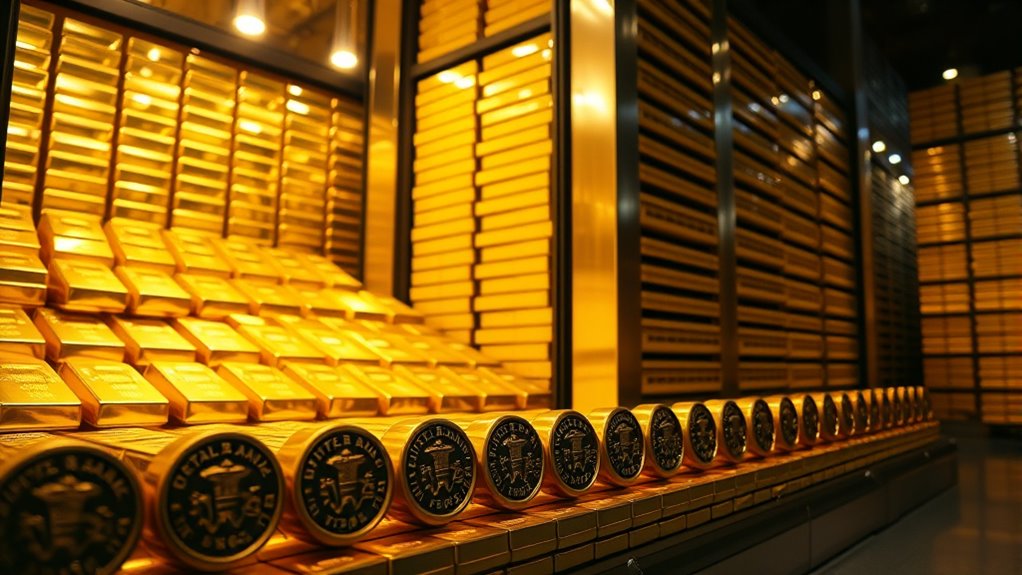Central banks are increasing their gold holdings to protect against currency devaluation, inflation, and geopolitical risks, viewing gold as a reliable safe haven. They actively diversify their reserves beyond the U.S. dollar, aiming to strengthen economic stability during crises. This trend signals strong global demand for gold and suggests it remains a key asset for safeguarding wealth. Understanding why central banks buy gold can help you see its importance in today’s uncertain economic landscape—more insights await if you explore further.

Central banks around the world are increasing their gold reserves at a remarkable pace, with over 1,000 tonnes purchased each of the last three years—far surpassing the previous decade’s average of 400 to 500 tonnes. This surge highlights a significant shift in how countries view gold as a strategic asset. You might wonder why these institutions are pouring so much into gold, especially when prices are hitting record highs. The answer lies in the current geopolitical and economic uncertainties that threaten global stability. Central banks see gold as a reliable hedge against risks like currency devaluation, inflation, and potential trade conflicts. It’s a way to diversify their reserves beyond the U.S. dollar, which many are actively reducing due to geopolitical tensions and shifting alliances. Over 90% of surveyed central banks expect their gold holdings to increase in the coming year, showing a consensus that gold remains essential in safeguarding national reserves.
Many central banks are not just passively holding gold—they’re actively managing it. Recent surveys reveal that 44% now actively oversee their gold reserves, up from 37% last year. Their confidence in gold’s strategic value remains high. In fact, about three-quarters of them believe that gold’s share of total reserves will grow over the next five years, despite rising prices. This indicates a long-term view that gold can serve as a safeguard in turbulent times. Emerging economies, in particular, are increasing their gold holdings more aggressively, driven by geopolitical tensions and concerns over dollar dependency. By diversifying their reserves into gold, they aim to insulate themselves from potential economic shocks and geopolitical disruptions. Furthermore, the increased active management reflects a strategic focus on optimizing returns and managing risks associated with gold holdings. Additionally, the global trend towards diversification underscores the importance of understanding economic stability and how gold can serve as a buffer during times of crisis.
For investors, this ongoing central bank activity signals strong underlying demand. Despite gold’s high prices, central banks continue to buy, marking 15 years of consistent net purchasing. Their actions reinforce gold’s reputation as a safe haven—especially during periods of economic instability. As these institutions bolster their reserves, it boosts investor confidence, making gold an attractive store of value. Countries like the U.S., Germany, and Italy hold significant gold reserves, but the global trend shows rising interest among other nations. The strategic importance placed on gold by central banks suggests that demand is unlikely to wane, even as prices rise. For you, this means gold remains a fundamental part of a balanced portfolio—an insurance policy against uncertain times and a testament to its enduring value in a shifting world.
Frequently Asked Questions
How Do Central Banks Decide When to Buy or Sell Gold?
You might wonder how central banks decide when to buy or sell gold. They base their decisions on economic conditions, currency stability, and geopolitical risks. If there’s economic uncertainty or inflation fears, they buy gold to protect reserves. Conversely, they sell when they need liquidity or to adjust their reserve portfolios. Their actions aim to maintain economic stability, diversify holdings, and safeguard against financial risks.
What Impact Does Central Bank Gold Buying Have on Global Gold Prices?
You might notice that when central banks buy gold, it gently nudges prices upward, creating a steady bullish rhythm. Their increasing reserves signal confidence in gold’s stability, encouraging investors like you to view it as a safe haven. As demand rises, prices could climb further, especially with forecasts pointing to $4,000 by mid-2026. This ongoing interest hints at a resilient, long-term opportunity for your investment portfolio.
Are There Geopolitical Reasons Behind Increased Central Bank Gold Purchases?
Yes, there are strong geopolitical reasons behind central banks increasing their gold purchases. You’ll see that countries face sanctions, currency instability, and shifting global power dynamics, prompting them to diversify reserves and reduce reliance on fiat currencies. Gold acts as a safe haven during geopolitical tensions, so central banks buy more to protect their economies and assert financial independence amid rising tensions with major powers like the US, China, and Russia.
How Does Central Bank Gold Accumulation Influence Currency Stability?
Think of gold as the anchor in a stormy sea; when central banks accumulate more, it steadies the currency’s ship. Your currency gains stability because gold acts as a non-correlated asset, shielding against depreciation and exchange rate shocks. This diversification reassures markets and investors, creating a strong foundation for confidence. As reserves grow, your country’s monetary credibility strengthens, making your currency more resilient amid geopolitical and economic turbulence.
Can Central Bank Gold Reserves Affect Individual Investment Strategies?
Central bank gold reserves can substantially influence your investment strategies. As central banks boost their gold holdings, it signals ongoing confidence in gold’s stability, which may drive prices higher. You might consider increasing your gold exposure for diversification and risk management, especially during times of geopolitical or economic uncertainty. Monitoring central bank moves helps you identify ideal entry points, ensuring your portfolio stays resilient amid market volatility.
Conclusion
As a savvy investor, you should watch central banks’ gold purchases like a hawk—these moves signal shifts in global stability and confidence. When they add gold to their reserves, it’s like planting a sturdy tree in a storm, ready to weather any financial upheaval. Staying alert to these trends helps you stay ahead, turning the unpredictable landscape into a navigable map, guiding your investments safely through the tumultuous waters of the global economy.









